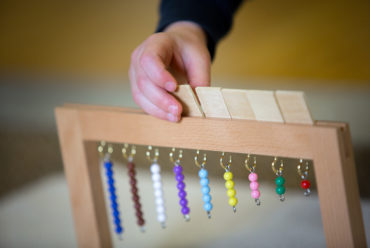How a Montessori Adolescent Program Prepares Students for High School
I have taught the Montessori Adolescent Program now for six years, and can think of no better way to prepare today’s young adolescents for any upcoming high school experience, public or private. I have had administrators from high schools meet me and thank me for sending them such prepared, responsible and respectful students. It isn’t me doing that work in isolation, however. It is the Montessori Adolescent program.
As it is designed, the Montessori Adolescent program is beneficial because:
- It meets the adolescent where they are. (as one would expect from any Montessori level)
- It builds on the strengths of the developmental period.
- It readies the student for the next experience.
In truth, an adolescent program was never designed by Maria Montessori as she had done with the lower levels, but rather the programs that are in existence today, and proving very successful, are based on the observations and experience of Dr. Montessori as outlined in her book From Childhood to Adolescence; Including Erdkinder. This collection of essays outlines the primary attributes of adolescents’ plane of development, and how to best work with these in an academic setting.
Dr. Montessori’s preferred method was a farm school, some of which are long established in the United States. However, given the educational system of our country in the 21st century, this format is not universally realistic nor responsive directly to the upcoming high school system as it stands. Therefore, accommodations have been made to meet the demands of higher education without compromising the goal of Montessori ideals. Primarily, setting up young adolescents for success in high school comes down to incorporating creativity and choice, collaboration and the social nature of adolescents, and strengthening growing independence through organization and time-management skill building.
Young adolescents have the potential for new thinking capabilities.
They are learning to reason hypothetically, plan ahead, understand analogies, and construct metaphors. Concentration is, however, often difficult; young adolescents are easily distracted. To this end it is important to engage students authentically and deeply. This is best accomplished by giving students choices of several options across the curriculum and granting them opportunities for creating unique responses or products. In a Montessori middle school program, students choose novels for literature, activities for science, areas of research and action in Humanities, and electives, among several other organic options in a classroom setting. Not having to be a part of a prescribed curriculum grants the young people a sense of authority over their education.
Choice is one of the eight pillars of a Montessori education, as stated by Angeline Lillard in Montessori: The Science behind the Genius. Choice is also one of the strongest factors influencing motivation to read among middle school students. Put that together and you cannot deny that granting choice wherever and whenever possible will strengthen engagement in a middle school classroom. Capitalizing on their newfound reasoning abilities allows teachers to provide challenges, projects and presentations that students can take on enthusiastically. Students who have experienced this level of engagement with their teachers and curriculum have earned themselves the badge of lifelong learner, and enter into further education endeavors eager and ready to meet the standards.
No one can deny that adolescents are social beings.
At this age, their friends are critical to every facet of a middle school student’s happiness. To capitalize on that facet of this plane of development, the Montessori program incorporates many options for socializing that are integral to their learning. Students participate in group presentations at the end of every cycle, group activities during any content Again, across the curriculum, students are encouraged to debate, defend, share, assert, converse, and challenge the presented content. Fully half of the curriculum is delivered in a small group setting, with the expectation of “collaborate; don’t separate”. Students learn to practice acceptance, equity, sharing responsibility, accountability. For many, initially there is struggle and frustration with these concepts, and perhaps working with certain individuals. After the course of the two-year program, however, most students find group work productive and painless, creating thoughtful presentations. Therefore, Montessori students enter high school more skilled and patient in the face of working with others; all others.
The adolescent is working with an only partially developed brain; the frontal lobe is still under construction.
Thus, an adolescent’s ability to think long term and to consider consequences is lacking. The adolescent program in Montessori, however, challenges this norm by presenting academics with prepared materials and a curriculum set up to promote students’ inherent abilities. Materials in the adolescent program model for students what may be for them different ways to organize. For instance, all the different curricular areas are printed on a different colored paper. Seems simple to you and me, but for students this can be groundbreaking, and can make all the difference with their own grasp of their materials and success with completing and turning in work. Also, the program is centered on five cycles of work, each being only five weeks long and consisting of what is essentially a three part lesson; ‘introduction’ including vocabulary, ‘association’ including handling materials, and finally ‘recall’ which consists of the presentation of learned concepts. The five-week cycle is a much more manageable time frame for young adolescents, and a stepping stone to high school and university semesters. Given these tools, and others such as a weekly seminar on study skills for academic success, Montessori Middle School graduates enter high school more than ready to handle the workload, test preparation, changing classes and teachers, and any extracurricular activities.
Montessori Middle Schools prepare young people to enter the world of higher education armed with these and many more critical characteristics of successful students. Capitalizing on their creative problem-solving skills, ability to collaborate effectively, and organize and manage the demands of school, means an incoming freshman class of students who are equipped and ready for the rigor of high school. Graduates of a Montessori middle school are often recognized by teachers and administrators as the most strongly capable students in any incoming class.
Many of our graduates who return to us to visit remark that they are finding high school to be ‘easier’ than middle school, and credit the program with preparing better than the high schools expected them to be! Now there’s a testimony you can’t argue.










Thoroughly enjoyed your article. My two grandsons are loving their public Montessori education in Charlotte, NC. I’m a former English teacher and guidance counselor. Can’t pass up a grammatical error. There’s one I frequently make in your article; so I’m super sensitive to it! Just thought you’d like to know. Keep up the great work! Norma
Go to this paragraph, then 8 lines down:
“The adolescent is working with an only partially developed brain; the frontal lobe is still under construction.”
“Seems simple to you and I….” should be, “…you and me,” as in, “Seems simple to you and to me.”
Thanks for your feedback Norma! We are glad you have been enjoying our blog and hope you will refer our site to others in the Montessori world.
Another twist on this game is to put a blob of paint of the correct
colour on each spot on the mat for a messy, slippy, funnier version of the classic game.